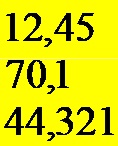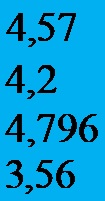It is very important to know how to order decimals from least to greatest in certain everyday situations. This procedure of comparing decimals can help us in everyday life if we want to make quick approximate conclusions regarding decimal numbers, percentages, or their corresponding consideration in the form of a fraction. Let’s just say that this type of decimal estimate should depend on how much profit or loss you may incur as an individual or a single business! It’s important! That is why this simple procedure is extremely important for every person.
It is for this reason that our team will pay special attention to this page that is in front of you. Below you can read rules for comparing and ordering decimals that will help you without much thinking and without a pencil and a sheet of paper to make correct conclusions in all those everyday situations when you need to correctly order decimals from least to greatest.
That’s why we recommend that you spend a few minutes on our site and look at its entire content. The examples that you can look at below will help you to order decimals from the least to the greatest in the future without any problem, and without doubting whether you are surely right or not! Continue reading below:
Ordering decimals
When ordering decimals from least to greatest, we should pay attention to the given decimal numbers to be ordered, and carefully compare them with each other (or with several other decimals) by keeping in mind the place value of each of the decimal numbers.
When ordering, it is best to arrange the decimal numbers one below the other, making sure that the decimal point of each number is placed one above the other. If we achieve that, all that remains is to compare the decimals by comparing their digits, starting from left to right (from the digit with the highest place value).
So, if during this comparison, the digits that we compare at the beginning are different, then the larger decimal number is the one with the larger digit, and conversely, the smaller decimal number is the one with the smaller digit. If the two digits are equal to each other, then we continue comparing the next digit on the right side of the ones we have already compared, until we come across digits that are different in size!
Examples On How To Order Decimals From Least To Greatest
Take a good look at the examples presented below on this page:
Example 1
Example 1: Order the decimal numbers from least to greatest!

Obviously we need to line up three different decimals. Therefore, in the first step we need to properly, in the correct way, arrange them one below the other, while taking care to precisely place the decimal points one below the other.

Then we start comparing! First, we compare the digits that have the same place value in the leftmost numbers. Thus, it is seen that the value of tens in the decimal number written above (at the top) is the smallest compared to the other two (1<4<7). Therefore we conclude that the number 12.45 is the smallest. On the other hand, the tens digit of the second decimal number (written in the middle, above) is the largest compared to the other two (7>4>1). Therefore, we conclude that the number 70.1 is the largest.
Finally, the decimal number 12.45 is the smallest, the decimal number 44.321 is in the middle, and the largest is 70.1.
The sequence of decimals ordered from least to greatest is:
12.45; 44,321; 70.1
Example 2
See also the second example:
Example 2: What is the correct order of the decimal numbers written below:

First, we arrange the decimals correctly, one below the other, paying attention to the place value and the digits:

Then, by comparing their leftmost digits, it is clearly seen that the fourth number has the smallest digit (3<4<4<4). Therefore, the conclusion we will draw is that the number 3.56 is the smallest of all four numbers. All the other three decimal numbers have the same leftmost digit. Therefore in this check we cannot draw a correct conclusion about their correct ordering.
In this case, we continue by comparing their digit, which is on the right side of the one we were already comparing! Let’s do it.
It is seen that the numbers in this decimal place have the digits 2, 5, and 7. Since 2<5<7, we proceed by arranging them in the appropriate sequence. The number containing the digit 2 is greater than the smallest decimal number that we verified in the previous step. The decimal number containing the digit 5 in the corresponding place is even greater. So the largest decimal number contains the digit 7. Thus, we have successfully performed correctly ordering the decimals from least to greatest.
The entire sequence of decimal numbers that are arranged correctly from least to greatest reads:
3.56; 4.2; 4.57; 4,796
Video Examples
The video presented immediately below this paragraph contains many more examples! They all cover how to order decimals from least to greatest. Feel free to take a look at this way of presenting information!
Feel free to ask for additional help if you feel that you need one! We will do our best to help you!





